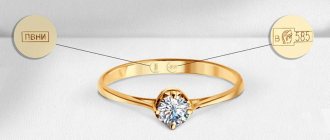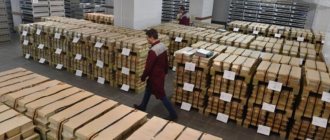What is a gold nugget
A gold nugget is an opaque piece of native gold (ore rock) enriched with minerals. In terms of its chemical composition, it is a frozen natural solution of a compound of silver, precious metal and impurities.
Native gold contains up to 10% of ores found in rock deposits. Combines with iron, copper, platinum, iridium, osmium. The shade of the nugget depends on them.
View this post on Instagram
Posted by JEWELRY • MAGADAN • (@zoloto_999_magadan) Nov 16, 2015 at 5:18 PST
Description of native gold:
| Options | What it looks like in nature |
| Dimensions | Nuggets include a single piece of gold over 2 grams, the weight sometimes reaches more than 100 kg. Formed in the form of dust (sand), grains less than 5 mm. |
| Color | Yellow (lemon to amber), yellow-red, silver-white, possible greenish tint |
| Color of crushed nugget | Yellow |
| Surface | Dull or bright, with a metallic sheen, smooth or uneven, there are notches, notches. Sometimes covered with another rock (called “shirted”) |
| Form | Bizarre, reminiscent of geometric shapes, plates, animals, feathers, branches and other objects |
| Hardness | Soft, corresponds to 2.5–3 points on the Mohs scale |
| Try | 800–950 (high-quality native gold). The more impurities, the lower the sample |
Often gold is connected to stones because it was formed at the same time as them or crystals began to grow around the precious metal. It occurs inside the mineral, on its surface, or lies separately from the destroyed gem.
There are stones with yellow shiny inclusions, reminiscent of gold. They don't actually contain precious metal.
To see what nuggets look like:
How is it different from pyrite?
Pyrite is a shiny mineral similar to gold. The gem is straw-colored, but when crushed, the powder turns out not yellow, but green-black.
Hardness also varies. For pyrite it reaches 6.5 Mohs points, and for the precious metal it does not exceed 3.
It also differs in cleavage. When native gold is struck, it becomes deformed. Pyrite crumbles into pieces and dust, and can create sparks.
Found a gold bar - you have to pay for it
In this article:
- What will the story tell?
- How to search and where?
- How can you mine Au?
How to look for gold and where can you find it? This question still interests gold miners today.
The current topic of searching for precious metals and a gold mine, which will solve all material problems in one hour, worries people all over the world.
Despite the fact that reserves of metal in nature have been greatly depleted, this does not prevent people from looking for gold and finding it in the form of nuggets or sand.
In Russia, with its vast territory and rich mineral resources, finding metal is not so easy; geologists and amateurs are engaged in the search.
Attention
It is difficult to say which of them will be lucky, but the excitement around gold does not subside, but, on the contrary, is gaining momentum.
Info
What will the story tell? How to find gold and where to look for it? Ivan III was the first of the kings of Rus' to ask this question.
How to determine the presence of precious metal in a stone
The authenticity of native gold is determined in the field or at home using a folk method.
What to do:
- If the golden inclusion under the mineral layer is barely noticeable, the stone is chipped or broken. When struck, the precious metal does not crumble.
- Having provided access to the inclusion, its surface is scratched with a steel needle.
- The scratched area is examined through a magnifying glass. The gold-containing element will not be destroyed; lines will remain on it where the needle is pressed.
The presence of gold dust in a stone is checked using iodine. An alcohol tincture from a pharmacy is suitable.
What to do:
- Grind the mineral into powder.
- Place the mineral powder in a jar or other container.
- Pour iodine into the powder and stir until smooth. Wait until a precipitate forms.
- Immerse a strip of white paper towel or filter paper (2 cm wide) into the liquid so as not to stir up the sediment. Immediately remove and dry at room temperature.
- The action of the previous paragraph is repeated 4–7 times.
- After drying, the paper is placed on a heat-resistant saucer and set on fire. If the stone contains precious metal, the ash will be purple in color.
There are few stones containing gold-bearing inclusions. The precious metal is found in granite, quartz and quartz diorites. Not all shiny minerals are classified as valuable specimens. But varieties of pyrite, sphalerite, galena and stibnite often lie next to the precious metal.
See an alternative option for finding gold:
Found it - don't be silent
The thirty-five-year-old city dweller faces up to five years in prison. She is accused of illegal possession of gold. According to investigators, last fall a woman on the side of a local road came across an amazing find - 24 ingots of spot gold. Their total weight is more than 8 kilograms. If we remove the impurities, the pure gold in the bars turned out to be more than seven and a half kilograms.
The lady kept the precious find, which the investigation estimated at 19 million rubles based on its official value alone, and kept it in her car. But she was lucky only once. The car was stopped by law enforcement officers and the gold was taken away.
A little later, the lady was charged with a very bad article, Article 191 of the Criminal Code of the Russian Federation - “Illegal storage and transportation of precious metals in any form, condition, with the exception of jewelry and household products and scrap of such products, committed on a large scale.” Now a judge is waiting for her, perhaps even the one who has already heard a similar case in the same district court.
His defendant was a man who, in 2015, in the forest came across a package containing loose gold and an ingot. And in this case, the citizen did not inform the authorities that he had picked up something valuable. Later, the investigation received the official value of the expensive find - the price of alluvial gold and the bullion, according to the Central Bank, amounted to more than five million.
It is clear that in the region where gold is mined, similar finds may occur. Citizens know about this. But law enforcement agencies are also well aware of this, having learned to search for and find illegal cargo. So the citizen was not lucky for long. His car was stopped, the discovery was found under the driver's seat and a criminal case was opened. The find weighed almost three kilograms, which is considered a significant weight that affects the severity of the punishment.
The investigation never found who hid the gold. It could have been simply stolen from an official organization that washes gold, or it could have been mined illegally. It also remains a mystery what prompted the man to hide the valuable cargo.
Considering that the man who found the gold was clean before the law, the court took pity on him and gave him a suspended sentence of one and a half years with a probationary period. Well, the gold went to the treasury. So there are valuable finds, but they bring more problems to the lucky ones than joy.
Sometimes law enforcement officers are lucky enough to find expensive finds. In 2012, in Chukotka, in Bilibino, a canvas bag was found in a house near an abandoned mine. It was clear from everything that it had lain there for many years, and the owner never returned for it - he had disappeared somewhere. But according to the law, it was against this unknown owner that a criminal case was initiated. There is no surprise in this - this is what the law requires.
Judicial practice shows that keeping illegal finds for yourself is a risk of ruining your life for a long time.
A whole kilogram of gold ore was found in the bag. It could very well be that the bag had been lying in a cache since distant Soviet times, when life was in full swing here, various citizens from all over the vast country came to earn big money and gold was actively mined. Later, the investigation into the mysterious owner of the bag of gold ore was stopped due to the impossibility of finding the suspect, and the contents of the bag were handed over to the state.
These and similar finds - if the lucky person keeps them for himself - will ruin his life for a long time. But not only ingots and kilograms of precious metal ore are capable of this. Serious problems can also arise from less expensive, but no less dangerous finds.
A similar incident occurred several years ago in the Chelyabinsk region. There, a sentence was passed on an elderly woman who was found in possession of a live cartridge. A pensioner picked him up at a training ground. And then she herself could not really explain why she brought it home and kept it for some time as a souvenir.
An examination carried out later, commissioned by investigative authorities, showed that the woman kept a domestically produced 9 mm caliber cartridge at home. This ammunition is suitable for firing from Makarov and Stechkin pistols, Cypress, GSh-90, and Kedr submachine guns. Special forces units are supplied with such weapons.
In general, everything in this case ended in a criminal case and in the dock. The Magnitogorsk court, however, did not send the pensioner to any colony, but sentenced her to a suspended sentence of two months in prison. But for a 75-year-old woman, this is already a severe punishment.
Current criminal legislation suggests that ignorance of the law does not excuse one from responsibility. Therefore, it is better to hand over any discovery to law enforcement officers. Especially when it comes to something that is legally prohibited from being owned and that, by definition, cannot be kept at home. Any law enforcement officer can tell you about the poor people who were found, for example, with weapons that were thrown away by criminals, valuables involved in criminal cases, and other things. And the finder turned out to be a defendant in a criminal investigation. Then he argued for a long time that he was just passing by and found it. By the way, criminals like to get rid of evidence by throwing it away so that someone will find it.
How are gold nuggets formed and where can you find them?
There is no evidence of exactly how the natural precious metal was formed. Previously it was believed that it increased due to crystallization, as during the formation of granite. Most scientists recognize the original molten state of native gold with the same composition as now. Perhaps the process began during volcanic eruptions, then the metal cooled in the cavities of the rock.
The main deposits of gold nuggets in Russia:
- Natalkinskoye (Omchak river, Magadan region);
View this post on Instagram
Posted by magan15 (@magan153689) Oct 14, 2021 at 11:04 am PDT
- Nezhdaninskoe (Yakutia);
View this post on Instagram
Publication from Industry of Russia and the World (@tekkos_russia) February 10, 2021 at 5:13 PST
- Olimpiadinskoye and Blagodatnoye (Krasnoyarsk Territory);
View this post on Instagram
Posted by Ivan (@ivankrivogov) Oct 28, 2021 at 6:34 am PDT
- Darasunskoe (Chita region).
In the Urals, native precious metal abounds in the Tash-Targanka river (near Miass), Moss swamp, Bolsheshaldinskaya placer and quarries in the Sverdlovsk region. The Kajaran and Sotskoe deposits are famous in Armenia.
A metal detector and a mini-dredge (a device for washing the soil) will make the search easier.
Which metal detector is better to take for a search:
- pulse;
- multi-frequency (from 6 to 60 kHz);
- with the ability to work underwater (waterborne).
In equipment reviews, experts highlight the Minelab Eureka Gold and Nokta Fors Gold metal detectors.
It is advisable to search not far downstream or along the perimeter of the quarry. In these zones there is a higher probability of finding nuggets. In swampy and excessively wet soils, it is recommended to do blind mole. That is, to drain water, holes with a diameter of 6–8 cm are drilled to a depth of 50 cm and with a frequency of 1 piece per 1–2 m.
Search at waste landfills
Russia is exceptionally rich in gold deposits.
Numerous deposits have been discovered from the Moscow region to Kolyma.
Among them there are mines that have been worked out industrially and have lost interest for the owner of the enterprise. For this reason they are closed.
Here, in small areas that were inaccessible to the bulldozer, there is still a lot of gold left. At such sites, called technogenic placers, you can search for gold.
Until 2021, private individuals were not issued a license to search for gold at waste landfills. Those who unauthorizedly searched for gold in abandoned mines were prosecuted .
Now, any citizen of Russia has the right to obtain a special license and, as a private prospector, look for gold in technogenic placers. According to the new regulation, gold can be searched only by the surface method, exclusively using hand tools . The use of explosives is prohibited.
The initial registration of a license costs 7,500 rubles , it is valid for five years. License renewal – 750 rubles .
It is important to choose the right search area. There is a greater likelihood of finding gold in places where there were nugget placers, where bars weighing more than 50 grams were found. Otherwise, you may waste time and labor in vain.
It is known that nuggets weighing from 3.5 to 16 kg . So, it makes sense to look for gold in these places. But perhaps there are nugget placers located closer to your place of residence.
The reports of the territorial geological fund contain information about geological developments , in which you can find details of interest, it is available for review.
On waste dumps, judging by the experience of private gold miners, one searcher using a metal detector can find up to 20 grams of gold per day .
Nuggets are more often found on the surface of a formation once raised by a bulldozer during technological development.
After excavating the rock using an industrial method, rock with gold placer appears on the surface.
In the small basins located here, there is a chance of finding large pieces of gold. But it happens that such areas are littered with rocks , and it is impossible to approach the gold.
The bulldozer does not pick up small cracks; they can also contain nuggets weighing more than five grams. In short, you need to be patient to find your first nugget.
Methods for extracting precious metal from stones
Refining enterprises are engaged in the extraction of native gold from stone.
Industrialists use three methods:
- Dry. The mineral containing native gold is crushed to dust, then the powder is treated with chlorine under pressure.
- Chemical. Mineral powder is calcined at temperatures above 500 ºC, then processed with nitric and hydrochloric acids (HNO3 + 3 HCl).
- Electrolysis. The powder is mixed with hydrochloric acid, and a current is passed through the raw material (the precious metal precipitates).
The native gold is then purified many times to improve its purity. At the end it is melted and poured into ingots.
Watch the video for ways to extract stone:
What does a sign about a found piece of jewelry promise?
It is difficult to answer this question unambiguously, since at all times different peoples had their own interpretation of signs. However, there are also those that are very similar to each other. So, for example, if a woman’s earring was found on the street by a man, then this meant quick profit or some kind of success in a serious matter. For women, in turn, such a sign promised to soon meet strong love.
However, other jewelry, such as rings, pendants and bracelets, could bring loneliness, illness, childlessness or even divorce to a person. Therefore, more experienced people understand that jewelry found on the street should under no circumstances be picked up, as it may be subject to damage or a curse.
Viewed 210 times Asked 2013-02-08 11:33:13 +0400 in the topic “Securities” from Moscow
Now, if for example I found 20 kilograms of gold, for example, the question inside is what should I do with it? can I sell it somewhere? or do I need to tell where the thread is and get only the percentage? well, a 20 kilogram nugget for example... that’s what worries me: why should I give it to the state? and what will happen if I don’t give it to you, but the pawnshop will accept 20 kg =)
Delete |
What to do if you find a gold nugget
Native gold is the property of the state. For legal production, a license is issued. Next, the raw materials with precious metal are supplied to refineries.
If a nugget is found by chance, and this often happens at deposits, it must be handed over to the local tax authority. The finder will receive a 20% reward from the value of native gold (Article 229 of the Civil Code of the Russian Federation). Income and pension taxes will be withheld from the amount, and the remaining money will be transferred to a bank card.
Watch vlogs of how amateurs search for precious stones:
Is it worth picking up found jewelry?
Should I pick up the found item or not? - it all depends on the person. If he is a deeply religious person and easily susceptible to psychological influence, then it is better to pass by and not stop.
However, if a person is a deep skeptic, then it is quite possible to choose jewelry. In this case, there may be several options for events:
- Try to find the owner;
- Keep the product for yourself;
- Sell it;
- Sell and give the money received as alms;
Important! In order for the found product to be safe for humans and others, it is recommended to soak it in a solution of salt water, after which the jewelry is washed with holy water. If the gold is real, it can additionally be burned with fire - all these actions are called a purification ritual.
Where to donate the treasure?
If a gold nugget is found not on one’s own territory, then by law it must be given to the state. However, the finder will not immediately receive his compensation. You will be faced with tedious, lengthy paperwork: expert assessments, documentation verification, and much more. There are numerous cases where people waited for their money only after several years. What can be done in such situations? There is only one thing that will help – contacting a lawyer.
What will happen if those who find treasures do not hand over to the state? There is no criminal liability for concealing them. But the rule does not apply to treasure of archaeological or historical value. In this case, the state has the right to confiscate all found jewelry. If the search was not carried out on the territory of an important state monument, then there will be no criminal liability or fines.
Finding jewelry is quite a difficult process. It all depends on your luck and equipment. But now you know what to do and where to take it.











